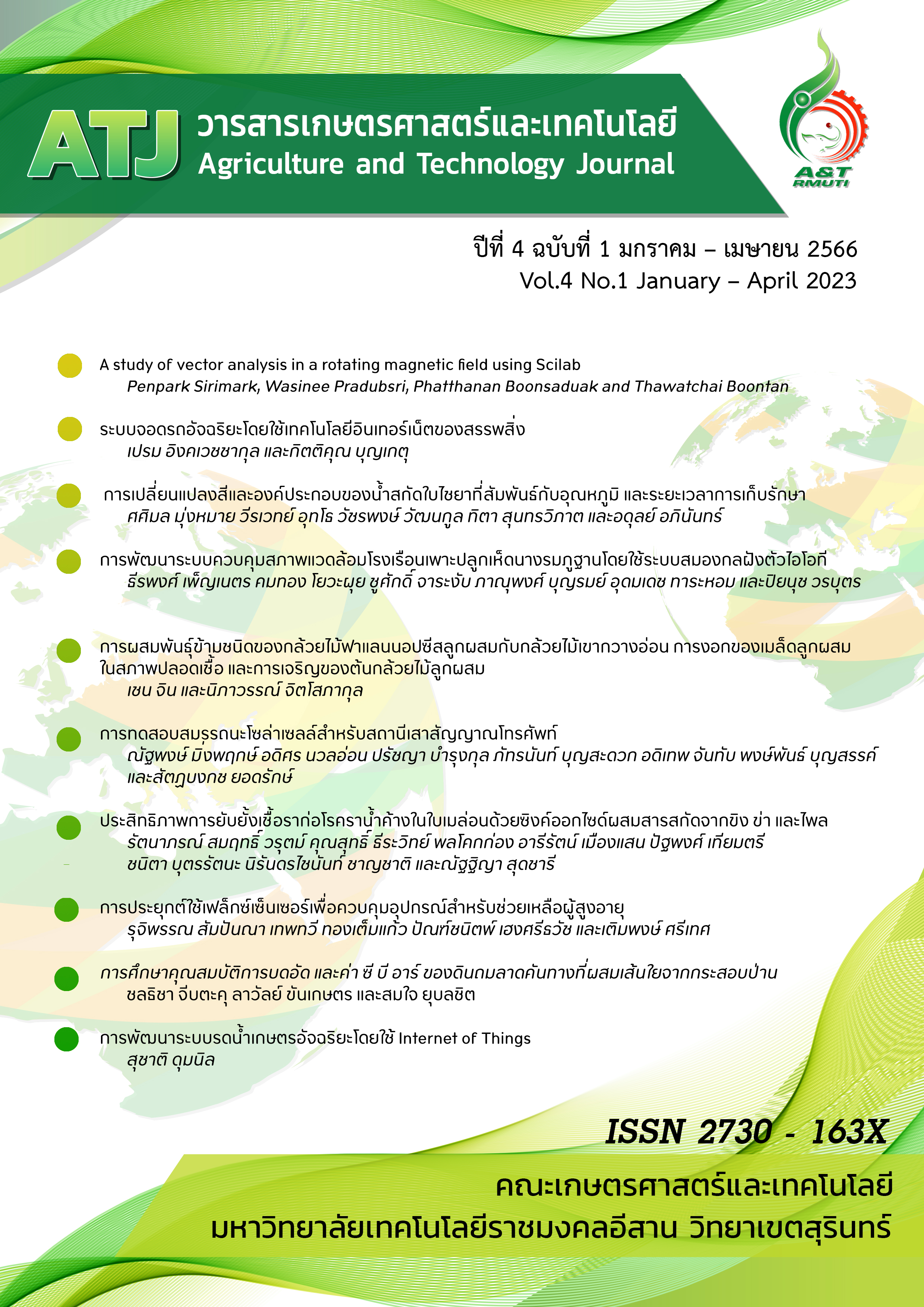Changing colors and compositions of aqueous chaya leaf extract in relations to temperatures and storage time
Keywords:
Chaya leaf, Chaya leaf extract, Kinetic, Total chlorophyll, Ascorbic acidAbstract
Aqueous chaya leaf extract has been used as food additive for improving taste and color of which the latter tends to change during storage. This research aim to study color changes and some components of the chaya extract kept between 5-25˚C for 10 days. The results showed that a* values as well as amounts of the total chlorophyll, and ascorbic acid continuously decreased from their initial values throughout the storage period especially when it storage in the high temperatures. The chaya extract kept at 25 ํC had only 3 days of self-life. The appearance of spoilage was observed from changing color to dark-brown color and precipitation. The results of kinetic studies on the quality attributed aforementioned found that the kinetic changes of those during the storage in individual temperatures were 1st order kinetic reactions. These were well predicted by the first-order fractional conversion (FOFC) mathematical model given values of R2 0.63-0.99 and root mean square of error (RMSE) <2, except the RMSE of a* values estimated at 10 and 25°C which were higher than 2. Rates of the kinetic changes estimated using the FOFC model exponentially increased in relations with temperatures increased. The relationships were well predicted by the Arrhenius mathematical model of which the values of R2 and RMSE were 0.76-0.99 and RMSE <2, respectively.
References
กัลยา นามวงศ์สา และ สุดารัตน์ สดสร้อย. (2563). ผลของสภาวะอุณหภูมิต่อการเปลี่ยนแปลงคุณภาพของผงใบไชยาในบรรจุภัณฑ์. รายงานการวิจัย. สาขาวิชาเทคโนโลยีการอาหาร คณะเกษตรศาสตร์ มหาวิทยาลัยอุบลราชธานี อุบลราชธานี.
เวียงโขง วันสะหว่าง, วีรเวทย์ อุทโธ, เอกสิทธิ์ อ่อนสอาด, วชิราพรรณ บุญญาพุทธิพงศ์ และเมทินี มาเวียง. (2559). ผลของการเก็บรักษาข้าวเปลือกในบรรจุภัณฑ์อุณหภูมิและระยะเวลาต่อคุณภาพของข้าวฮางงอก. วารสารเกษตรพระจอมเกล้า. 34(3): 73-85.
ศศิมล มุ่งหมาย, วัชรพงษ์ วัฒนกูล, อดุลย์ อภินันท์ และวีรเวทย์ อุทโธ. (2565). ผลของไอระเหยเอทานอลที่สะสมในบรรจุภัณฑ์แอคทีฟต่อการเปลี่ยนแปลงคุณภาพของใบไชยาสด. วารสารวิทยาศาสตร์และเทคโนโลยี มหาวิทยาลัยราชภัฏบุรีรัมย์. 6(2): 33-49.
สุรวิทย์ นันทการัตน์, ภาณุภัทร ตางาม, อนัญญา ไทยบุญนาค, บุญชัย ด้วงสวัสดิ์ และสุวรรณา รุ่งเรือง. (2559). การผลิตผงสีจากวัสดุธรรมชาติเพื่อผลิตภัณฑ์อาหาร. รายงานการวิจัย. สำนักงานการวิจัยแห่งชาติ (วช.) กระทรวงการอุดมศึกษา วิทยาศาสตร์ วิจัยและนวัตกรรม กรุงเทพมหานคร.
สำนักงานสภานโยบายการอุดมศึกษา วิทยาศาสตร์ วิจัยและนวัตกรรมแห่งชาติ. (2563). เอกสาร BCG in Action กลุ่มอาหาร. รายงานการวิจัย. สถาบันทรัพย์สินทางปัญญาแห่ง จุฬาลงกรณ์มหาวิทยาลัย กรุงเทพมหานคร.
Akyildiz A., Mertoglu T. S. and Agcam E. (2021). Kinetic study for ascorbic acid degradation, hydroxy methyl furfural and furfural formations in orange juice. Journal of Food Composition and Analysis. 102(1): 11-16.
AOAC. (1990). Official methods of the association of analytical chemistry international 16thEdition. Gaithersburg: MD.
Avila I.M.L.B. and Silva C.L.M. (1999). Modelling kinetics of thermal degradation of colour in peach puree. Journal of Food Engineering. 39(2): 161-166.
Deng L., Xiong C., Pei Y., Zhu Z., Zheng X., Zhang Y., Yang X., Lui Z. and Xiao Y. (2022). Effects of various storage conditions on total phenolic, carotenoids, antioxidant capacity, and color of dried apricots. Food Control. 136(3): 1-10.
Earle R. L. and Earle M. D. (2003). Fundamentals of food reaction technology. Leatherhead. NY.
Godínez-Santillan R. S., Chavez-Servin J. L., Garcia-Gasca T. and Guzman-Maldonado S. H. (2019). Phenolic characterization and antioxidant capacity of alcoholic extracts from raw and boiled leaves of Cnidoscolus aconitifolius (Euphorbiaceae). Acta Botanica Mexicana. 126(1): 1-15.
Ghosh S., Sarkar T., Das A. and Chakraborty R. (2022). Natural colorants from plant pigments and their encapsulation: An emerging window for the food industry. LWT-Food Science and Technology. 153 (112527): 1-12.
Hanh N.T., Hoang N.V. and Tao P.T.P. (2016). Change of chlorophyll and vitamin c in green peas (Pisum Sativum) during thermal processing. Veitnam Journal of Agricultural Sciences. 14(7): 1068–1074.
Indrasti D., Andarwulan N., Eko H.P.E.H. and Wulandari N. (2018). Stability of chlorophyll as natural colorant: a review for suji (Dracaena angustifolia Roxb.) leaves case. Current Research in Nutrition and Food Science. 6(3): 609-625.
Labuza T.P. (2005). Interpreting the complexity of the kinetics of the maillard reaction millard reactions in chemistry food and health. Woodhead publishing. Sawston.
Lichtenthaler H.K. and Buschmann C. (2001). Chlorophylls and carotenoids–measurement and characterisation by UV-VIS. current protocols in food analytical chemistry (CPFA), (supplement 1). John Wiley. NY.
Martins N., Roriz C.L., Patricia M.P., Barros L. and Ferreira I.C.F.R. (2016). Food colorants: challenges, opportunities and current desires of agroindustry to ensure consumer expectations and regulatory practices. Trends in Food Science & Technology. 52(1): 1-15.
Peleg M., Corradini M.G. and Normand M.D. (2004). Kinetic models of complex biochemical reactions and biological processes. Chemie Ingenieur Technik. 76(4): 413-423.
Phungam N., Utto W. and Pruthtikul R. (2018). Interaction between surface coating using cabbage leaf wax extract and temperature on water vapour and gas exchange properties of fresh okra (Abelmoschus esculentus (L.) moench). International Food Research Journal. 25(5): 1885-1892.
Prabhakar H., Bock C., Kerr W. and Kong F. (2022). Pecan color change during storage: kinetics and modeling of the processes. Current Research in Food Science. 5(1): 118-128.
Ramirez R.M.M., Metri O.J.C., Diaz M.G. and Baigts A.D.K. (2021). Use of chaya (Cnidoscolous chayamansa) leaves for nutritional compounds production for human consumption. Journal of Mexican Chemical Society. 65(1): 261-271.
Robertson G.L. (2012). Food packaging: principles and practice. 3rdEdition. Taylor and Francis Group. NY.
Rasul H. and Inanç A. (2014). Thermal stability of chlorophyll pigments in virgin olive oil. KSU Journal of Natural Sciences. 17(2): 34-40.
Sezgin A.C. and Ayyildiz S.V. (2017). Science within food: up-to-date advances on research and educational ideas. Food Additives: Colorants. Spain: Formatex Research Center. 3(1): 87-94.
Van L.A., Christiaens S., Colle I., Grauwet T., Lemmens L., Smout C., Van B.S., Vervoort L. and Hendrickx M. (2014). Kinetic data for biochemical and microbilogical processes during thermal processing. In Rao M.A., Rizvi S.S.H., Datta A.K. and Ahmed J., Edition. Engineering properties of foods. Boca Raton. Springer Singapore. London.
Yang C.C. and Chinnan M.S. (1988). Modeling the effect of O2 and CO2 on respiration and quality of stored tomatoes. Transactions of the ASAE. 31(3): 920-925.
Downloads
Published
Versions
- 2024-02-19 (2)
- 2023-04-29 (1)
How to Cite
Issue
Section
License
Copyright (c) 2023 Agriculture and Technology Journal

This work is licensed under a Creative Commons Attribution-NonCommercial-NoDerivatives 4.0 International License.
เนื้อหาและข้อมูลในบทความที่ลงตีพิมพ์ในวารสารทดสอบระบบ ThaiJo2 ถือเป็นข้อคิดเห็นและความรับผิดชอบของผู้เขียนบทความโดยตรงซึ่งกองบรรณาธิการวารสาร ไม่จำเป็นต้องเห็นด้วย หรือร่วมรับผิดชอบใดๆ
บทความ ข้อมูล เนื่อหา รูปภาพ ฯลฯ ที่ได้รับการดีพิมพ์ในวารสารทดสอบระบบ ThaiJo2 ถือเป็นลิขสิทธิ์ของวารสารทดสอบระบบ ThaiJo2 หากบุคคลหรือหน่วยงานใดต้องการนำทั้งหมดหรือส่วนหนึ่งส่วนใดไปเผยแพร่หรือเพื่อกระทำการใดๆ จะต้องได้รับอนุญาตเป็นลายลักอักษรณ์จากวารสารทดสอบระบบ ThaiJo2 ก่อนเท่านั้น







